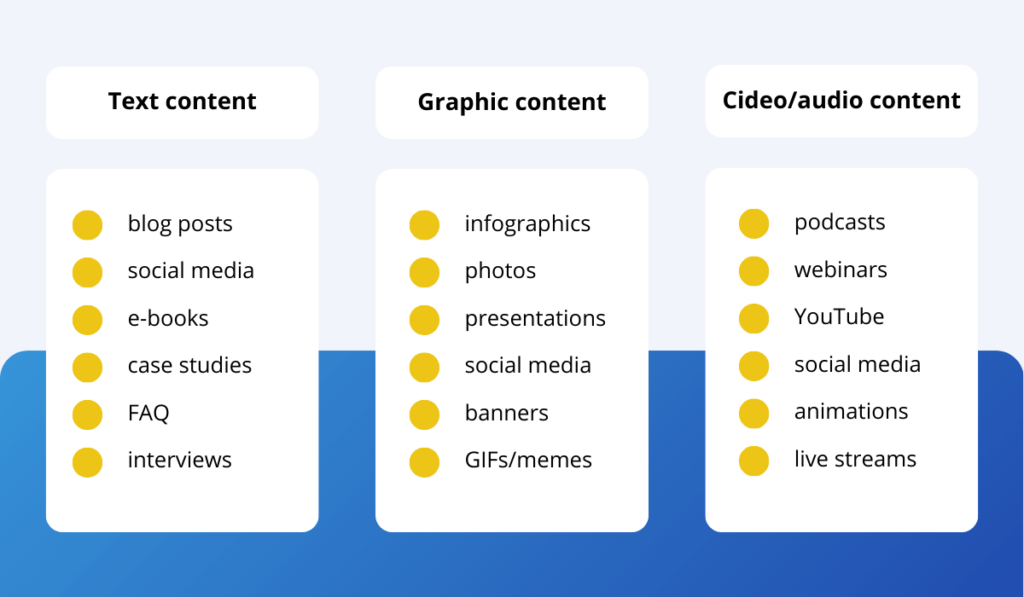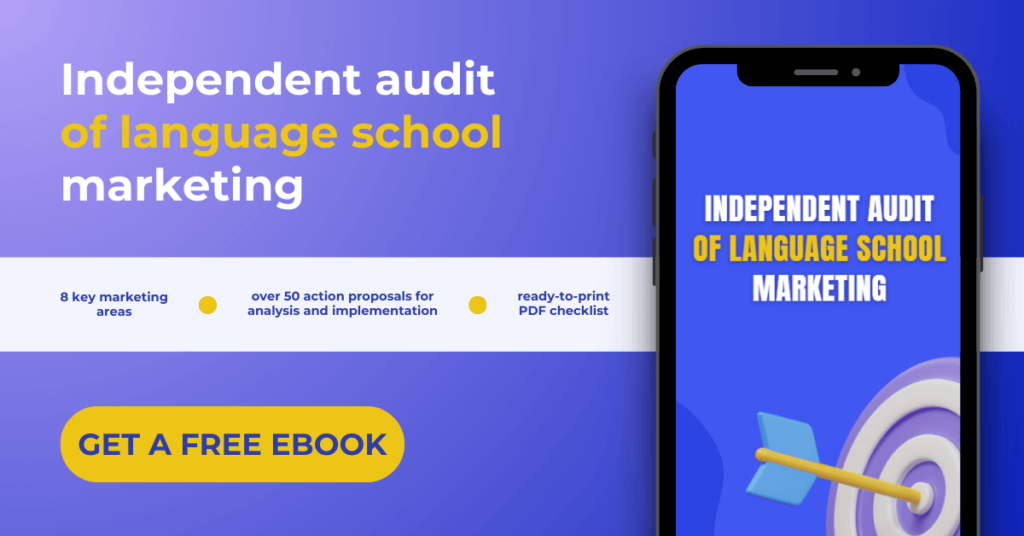
Content marketing is not only a way to increase the visibility of your language school but also to build trust, acquire new clients, and retain current ones. It’s an investment that brings long-term benefits in building a strong educational brand. Read the article and learn how to step by step utilize content marketing in a language school.
What will you find in this article?
- What is content marketing?
- Why is it worth investing in content marketing?
- Types of content in content marketing for a language school
- What are evergreen content?
- 7 steps to your own content marketing strategy
- Summary – content marketing in a language school
What is content marketing and why is it worth investing in?
Content marketing is a strategy that involves creating and publishing valuable content to interest, attract, and engage a specifically defined group of audience, who in this way become our clients. Content marketing in a language school allows for building a strong and long-lasting relationship with potential students and their parents by engaging them with valuable and practical content.
DID YOU KNOW…?
✔︎ 58% of marketers reported an increase in sales and revenue in 2023 thanks to content marketing. (Content Marketing Institute)
✔︎ 66% of B2B marketers consider the needs of their audience, rather than sales goals, when creating content. (Siege Media)
Why is it worth incorporating content marketing into the promotional activities of a language school? There are many reasons, but below you will find the most important ones.
Building trust and an expert image
Publishing educational content, such as articles, videos, or infographics, allows the school to be presented as an expert in its field. Potential students and their parents are more likely to choose a school that provides them with useful information, imparts knowledge, and inspires.
Better search engine optimization (SEO)
Regularly creating content optimized for SEO allows for better visibility in search results. Keywords such as „English course for kids” or „online language school” can attract organic traffic to the school’s website. However, remember the basic function of Google’s algorithms – they were introduced to limit the possibility of „artificially” boosting page rankings. They can become our allies if they receive what they like, which is valuable and original content.
Attracting and engaging potential clients
Content marketing in a language school works like a magnet – valuable content attracts individuals interested in learning languages. When preparing content, always consider the needs of your target audience. If you address them – you will surely encourage potential clients to engage!
Increasing loyalty of current students
Creating additional educational content, such as learning tips, language quizzes, or supplementary materials, will boost the loyalty of your current students, strengthening their bond with you and ensuring they return willingly and regularly!
Long-term effects and cost reduction
Compared to paid advertisements, content marketing has long-term effects. An article or video created once can generate traffic and interest for many months or even years! However, remember that this is not a strategy that will bring you immediate results.
Ability to measure results and optimize strategy
When creating content, you can analyze data such as the number of page views, time spent on the site, or conversion rate. This, in turn, will indicate the areas that generate the most interest among your audience and allow you to better tailor your strategy to their needs.
The more you give, the more you get. Types of content in content marketing for language schools.
Content in content marketing can include not only articles but also videos, podcasts, posts, e-books, infographics, FAQ lists, or photos. You can find specific examples in the infographic below.

Most commonly, language schools opt for:
- Blog – where you can post language tips and information about lifestyle, culture, and work in a country where the language is used.
- Newsletter – it allows you to regularly inform subscribers about what’s happening at the school and promote courses and blog posts.
- Social media – primarily Facebook, Instagram, and increasingly – TikTok as well. Social media is excellent for building an engaged community.
- E-books – these can be used to publish conversation guides, exercises, or practical advice, for example. It’s important to ensure the e-book has an interesting design and to ask those who download it to leave their email address and consent to receive the newsletter in return.
When creating our content, we should aim for it to educate the audience and solve their problems or entertain them. Users will appreciate such content and will be happy to share it on social media.
GOOD TO KNOW!
Evergreen content refers to timeless materials in content marketing that remain valuable and relevant regardless of the passage of time. Unlike content related to fleeting trends or events, evergreen content provides long-term benefits, generating consistent traffic to the site and building expert authority.
These can include:
✔︎ guides (How to learn a foreign language at home?)
✔︎ lists (20 useful phrases in Spanish)
✔︎ tests and quizzes (Check your language level – take a quiz)
✔︎ answers to common questions (What to consider when choosing a language course?)
✔︎ additional language learning materials
✔︎ success stories of students and case studies
7 steps to your own content marketing strategy
Many companies specializing in content marketing operate on the market, but using their services often involves significant expenses. Initially, conducting such activities on your own can also yield good results.
After all, those who teach foreign languages are specialists in their field and possess valuable knowledge they can share with their clients. This advantage is not something any copywriter from an agency can offer. Before you start creating a strategy, consider what your goal is.
It could be:
- Increasing the number of course enrollments.
- Improving the engagement of existing students.
- Enhancing brand recognition.
This will make it easier to define the indicators through which you will measure the effects of the implemented actions (number of leads, reach, clicks, number of course enrollments).
To develop your own strategy:
- Gather as much information about your potential clients as possible: find out who they are, what drives them, and what their needs are.
- Create personas. Imagine three to five fictional characters and assign them the traits of your clients. Create every element of your content with at least one persona in mind.
- Ensure consistency in your messaging. Consider who you are, what you want to offer people, and how you want to be perceived.
- Define the goals of your content marketing actions. Remember to make them as specific and measurable as possible.
- Gather everything you have ever written or created and check what you can utilize in your marketing activities.
- Create a publishing plan. Decide what you want to publish and how often you can manage to do it.
- Publish and analyze. With free tools like Google Analytics, you can see which of your activities are yielding the best results. Draw conclusions and constantly strive to improve something.
Summary – content marketing in a language school
Promoting yourself through content marketing activities has one major drawback – it is quite labor-intensive. However, it is worth trying to find time for it because it can bring excellent results, as evidenced by examples of schools using this technique.
Do you want to gain more marketing knowledge? Download the free ebook Independent Audit of Language School Marketing!

